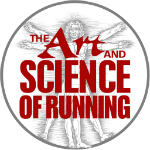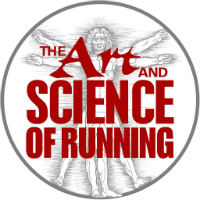Guest Bio
In this episode of the Art and Science of Running podcast, we speak with Max Paquette, Ph.D. about injury prevention, strength training, footwear, aging, adapting and quantifying training. Max is an accomplished runner as well as associate professor in the School of Health Studies at the University of Memphis, director of the Musculoskeletal Analysis Laboratory, and biomechanist within the Human Performance Center.
Max was a national level steeplechaser and coach in Canada as he studied and became an expert in the fields of biomechanics and injury prevention.
We follow Max on Twitter @BiomechMax and reached out to him after he tweeted:
Max and Jacob discuss Max’s tweet and why it was both comical and controversial.
As we have discussed in a number of previous episodes (four, nine, fourteen, fifteen), we start with the fact that the Nike “whatever percents” have been proven to increase running economy.
The findings are clear. These shoes work and if you want to run faster you should use them.
Max Paquette
Read the original research: “The Biomechanics of Competitive Male Runners in Three Marathon Racing Shoes: A Randomized Crossover Study.” Wouter Hoogkamer, Shalaya Kipp, Rodger Kram
Footwear & Injury Prevention
One of the most commonly asked questions about the Vaporflies is, “Do they reduce the risk of injury?” or “Do they increase the risk of injury?”
We discuss this anecdotally a bit in Episode 15 with Geoff Burns, but we also wanted to ask Max given his expertise in injury prevention.
There have really been no studies on shoes and running injuries. It’s really hard to tease out the single variable of shoes.
Max Paquette
There is a difference between “risk” and a definitive “cause” of injury.
Max has discussed this topic in other spaces as well:
Besides, runners get injured a lot. How do you define an injury?
What do the Vaporflies actually do?
These shoes seem to do two things:
- Decrease / reduce the amount of power required by the calf and metatarsal phalangeal joint (MTP Joint)
- They do a lot around the foot and ankle, but not as much at the knee and hips
Theoretically, wearing Vaporflies might help those with calf pain. Anecdotally, many runners report less pain / soreness in calves post-marathon after using the Vaporflies.
The stiff carbon plate plus the foam seems to help reduce amount of involvement of calves and Achilles tendon. This could potentially alleviate some discomfort or pain in rehabilitation of injuries in calves or Achilles which means they could be a promising footwear intervention while rehabbing from injuries to the foot and ankle.
The idea that a shoe could reduce injury . . . that’s the holy grail of shoe science and marketing! Runners want shoes to work so badly in reducing the risk of injury, but there is absolutely zero evidence in science to show that shoes prevent injury. The only aspect that has some evidence is the idea that rotating through a number of shoes might help reduce injuries. We’ve been told for so long that we need shoes to prevent injury, but there’s really no evidence that a specific shoe that prevents injury.
Max Paquette
Jacob and Malc concur with Max regarding the advantages of rotating through a variety of models and discuss that among other details regarding what to look for when selecting running shoes in these videos: Running Shoe Talk.
There are some theories that getting shoes based on comfort might be the best way to reduce injury. If you’re going to get hurt regardless, you might as well be comfortable.
Injury Prevention through Strength Training
The next big area of discussion with regards to running injuries is the idea of deliberate strength training with the primary goal of reducing the risk of injuries.
The idea is that is that through strength training you are making tissues (muscle, tendon, or bone) better able to handle running more easily.
We know that strength training has helped increase running economy. By increasing tissue capacity / tissue strength during injury to withstand the demands of running.
House analogy
When you build a house you would not put contents in first. You’d start with the structure before buying fancy furniture. The foundation of the house is tissue capacity. The contents of the house add load to the structure of the house (running).
Historically runners have been afraid of strength training out of fear of gaining weight, but the evidence from a performance standpoint shows that athletes should lift heavy. Lift heavy, but less volume.
It’s an engrained culture that if you lift heavy you are going to be heavy, but by lifting heavy you can improve how much your tissues can handle and therefore increase the capacity to increase running volume.
Prepare Body to Increase Load through Strength Training
We are training for running so running is the most important component. Everyone reaches a plateau at some point. It makes sense that you need to make your body more resilient which often comes through more running volume, but if your body can’t handle the run volume you need to prepare your body to increase load.
Max recommends 3-5 exercises that can be done with minimal additional equipment:
- Front squats w/ kettle bells
- Dead lifts or Romanian Dead Lifts w/ kettle bells
- Overhead push presses
- Lunges
- Calf Raises
If you only have 10 minutes a day, just do heavy calf raises with a straight leg and a bent leg.
STRENGTH TRAINING FOR RUNNERS SLIDE SHOW by Max Paquette
Running and Aging
Max co-authored an article with Rich Willy PT, Ph.D. entitled The Physiology and Biomechanics of the Master Runner. (Willy RW, Paquette MR (2019). The Physiology and Biomechanics of the Master Runner. Special Issue: The Ultra Endurance Athlete, Sports Medicine and Arthroscopy Review. Accepted, Ahead of Press).
We need to be careful when we study aging to make sure that we are not studying declines in activity and lifestyle. As we age we do things differently. We have more work and family commitments so we often train less and slower. In addition to decreased intensity, we often decrease the amount of time and volume of training that we put in which often leads to decreases in fitness and biomechanics advantages.
If we look at masters level world records – even at short distances – there is not a rapid precipitous decline not until after 65 years old. Beyond 60 or 70 years old you might call it a point of no return.
Lifestyle changes happen. Things change. There is usually a decreased capacity of calf muscles in line with shorter step lengths and a decline in speed.
Training does, in fact, help with healthy physiology and biomechanics later in age.
Strength training of the calves provides the biggest bang for your buck in all runners, particularly older runners. Consequently, it should play a role in reducing injuries in runners.
Given that VFs do much of the work in the ankle, I bet those shoes make a larger difference in older runners by reducing the amount of work demanded of the calves and the ankles.
Max Paquette
Cross Training for Runners
Max also co-authored an article about Cross Training for Runners Cross-training for runners: How athletes can maintain performance when training off the track. (Klein I, Paquette MR. (2016). Cross-training for runners: How athletes can maintain performance when training off the track. USTFCCCA. Techniques Magazine. Volume 11.) so Jacob asked Max what he considers to be the most effective forms of cross training and what to take into account when deciding which type of cross training to do.
First of all, we agree that in this instance, when referring to cross training we mean anything aerobic – anything that would tax the cardiovascular system (rowing, swimming, cross country skiing, biking, etc.) that is not running.
Cross training means that you are doing something to train the cardiovascular system while reducing impact on the musculoskeletal system.
Specificity
In longer races the cardiovascular system never really fails us. What fails us are the muscles. You need that specificity of smacking the ground with every step so that the demands on the musculature are specific to running. You can still supplement a lot of that volume with cross training as long as you ensure that at least some of the training is done as running to prepare the body for the demands of actual running.
Specificity is key. Try to replicate the mechanical demands of running to train specifically for running. For example, standing up on the Elliptical or a bike requires mechanical loading similar to that of running. The Elliptical is a better option than biking or swimming for runners because the biomechanics are a lot more similar. The mechanical demands when swimming are a lot less than cycling or Elliptical.
Quantifying Running
There are different ways to measure work in running. We are missing a lot by only quantifying weekly mileage because 60K one week is not the same as 60K the following week because 60K is not necessarily the same stimulus. A better measure is time (time spent per week) rather than simply mileage.
For further discussion about the advantages of measuring by time rather than distance please read, Duration vs. Distance Other metrics to use when measuring running include Relative Perceived Exertion, Heart Rate, and Color Continuums.
Case Study on Cross Training and Early Specialization
Max and Jacob continue their discussion about injury prevention and the role that playing sports other than running may plan in reducing injury in the future. Max grew up playing hockey and later cross country skied before getting too serious about running. As a result, Max increased strength and durability from side-to-side motions and was able to avoid most major injures even when running 100 miles per week. Jacob grew up playing basketball and has also remained relatively injury free relative to others who have been running for as long.
One of the challenges of early athletic success stories is that a lot of attention is given to those who are the exceptions rather than the rule such as Tiger Woods and Serena Williams. As David Epstein discusses in Range: Why Generalists Triumph in a Specialized World, Roger Federer follows a more traditional route to success by not overspecializing.
“All three [of the [Ingebrigtsen Brothers] were very physically active from a young age, and they [took] part in different sports.” In fact, even after they began running competitively they continued to cross country ski through the winters.
Three Norwegian brothers all European 1500 m champions: What is the secret?
Peak Run Performance Rocky Mountain Running Retreat
Join us this Spring for the Peak Run Performance Rocky Mountain Running Retreat April 30-May 3, 2020 in Canmore, Alberta, Canada. Use discount code ASR10 for 10% off when you register at Race Roster.
Shout Outs and Social Media
Intro and outro music GOIN 4 A WALK by Dallin Puzey.
Please listen, subscribe, rate, and review this podcast on Apple Podcasts, Spotify, Stitcher, YouTube, or wherever you listen to podcasts.
Please follow us on Twitter, Instagram, and Facebook and let us know what you’d like us to discuss in future episodes.
Podcast: Play in new window | Download
Subscribe: Google Podcasts | RSS




